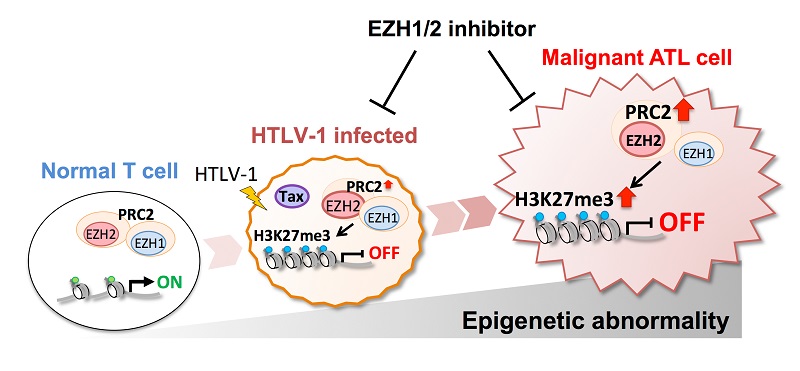New approach to adult T-cell leukemia therapy Targeting accumulated epigenetic disorder in T-cells


Epigenetic landscape of ATL development from HTLV-1 infection to accumulation of epigenome disorder
When T-cells are infected with HTLV-1, inappropriate histone methylation is carried out by the histone methylation enzymes EZH1/2. This epigenetic abnormality increases in extent and scope with the malignant transformation of T cells.
© 2016 Makoto Yamagishi.
A University of Tokyo research group has discovered that genome-wide epigenetic disorder is behind patterns of abnormal gene expression found in adult T-cell leukemia-lymphoma (ATL). Further, a newly-developed drug may induce repair of this disorder of the epigenome and shows promise as a novel therapy for ATL.
ATL is an aggressive T-cell leukemia/lymphoma caused by human T-cell leukemia virus type I (HTLV-1). There are more than one million infected individuals (carriers) in Japan. Because preventive therapies and effective treatments have not been established, there was a need for effective drug-based therapies.
The University of Tokyo research group of Professor Toshiki Watanabe, Project Assistant Professor Makoto Yamagishi and their colleagues found a distinct pattern of gene expression in tumor cells from ATL patients. More than half of the chromosomes of ATL cells showed an accumulation of epigenetic changes due to inappropriate activity by EZH1 and EZH2, enzymes that methylate histones, a type of protein around which DNA is wrapped for compaction. The research developed a new compound that could inhibit the function of EZH1 and EZH2 at the same time. This compound reversed inappropriate methylation of histones from ATL cells and also selectively eliminated ATL cells and HTLV-1-infected immortalized cells.
“Japanese researchers have contributed greatly to research in this area, discovering both ATL and the virus that causes it, the first retrovirus to be found in humans,” says Professor Watanabe. He continues, “This new discovery is the result of a long cooperation between many Japanese ATL patients and researchers. This is a great contribution to international clinical and basic research and an extremely important discovery.”
This research was carried out in collaboration with Daiichi Sankyo Co., Ltd.
Paper
, "Polycomb-Dependent Epigenetic Landscape in Adult T Cell Leukemia (ATL); Providing Proof of Concept for Targeting EZH1/2 to Selectively Eliminate the HTLV-1 Infected Population", American Society of Hematology Annual Meeting: 2015/12/8 (Japan time)
Article link (Publication)
Links
Graduate School of Frontier Sciences
Department of Computational Biology and Medical Sciences, Graduate School of Frontier Sciences






